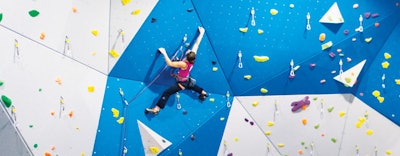
Call it a sport. Call it a recreational activity. Call it a great workout. Just don't call it a fad. Participation in rock climbing has been steadily increasing for years, and climbing walls — already commonplace in campus and municipal recreation centers — are popping up in high schools and elementary schools, parks and health clubs, even stadiums.
All of this exposure to the sport has whetted newcomers' appetites, fueling the demand for dedicated climbing facilities. "We're at the base of the serious growth period for climbing," says Jason Stollenwerk, managing director with Entre-Prises Climbing Walls USA in Bend, Ore. According to Climbing Business Journal, 28 climbing gyms opened in 2013, a significant number considering each facility contains thousands of square feet of climbing wall spanning heights of 50 feet or more, not to mention a growing list of other amenities.
"Facilities are getting bigger and the architecture is becoming a more important part," Stollenwerk says. "They have to be more inviting because they're getting people who are a little more discriminatory. People are looking for really clean, well-thought-out climbing gyms that offer other amenities — yoga classes, weight training, a fitness center, a coffee shop. Some gyms are even starting to offer childcare."
ONE WALL AT A TIME
Dedicated climbing facilities have been around since the 1980s, though most early facilities have very little in common with today's gyms. "When it started, it was out of necessity," says Adam Koberna, sales manager for Walltopia's Pittsburgh office. "It was a garage, a warehouse, a barn. That changed to facilities being opened up, but they were bare bones. They weren't always designed the best, and engineering wasn't up to code because people were doing it on their own. Anyone who went to those places was pretty committed."
They were, in essence, a place for dedicated climbers to train during inclement weather, uninviting and unappealing to the general public. It wasn't the best business model, admits Jerad Wells, CEO of Boulder, Colo.-based Eldorado Climbing Walls. "There were a handful of visionaries who understood climbers have no money and always want to climb for free, yet we have to keep these gyms maintained — how about we go after a larger market segment?"
And thus climbing walls started going up in college recreation centers in the 1990s, quickly becoming an essential weapon in the campus recreation arms race. "These campus and municipal rec walls have been a big driver for the climbing gym market," says Wells, adding of users, "They get that exposure and then think, 'This is fun; where can I do more of this?' "
Aside from bringing climbing to the forefront of recreation activities, installation of climbing walls in recreation centers took away many of the barriers to entry that had kept the sport out of the mainstream. "The majority of people who climb inside these days never do it outside," says Wells. "That speaks to a couple of things. One is the socialization of the sport. The other is that everything is done for them; they just have to show up, put on the equipment, pass a couple of tests, and there they go. It's not as scary as climbing outside and having to hike trails, find your routes, put your own protection into the rocks."
That convenience isn't lost on the outdoor climbing crowd, says Koberna. "There are a lot of people who have been climbing for years and never had access to facilities like this just because they weren't built. These outdoor climbers are coming back to the gym or spending more time there. It's an 'I never had it this good' kind of attitude."
It goes both ways, of course, says Michael Moore of Minneapolis-based Nicros Inc. Climbing Wall Systems, whose sister company, Vertical Endeavors, operates commercial climbing facilities throughout the Midwest. "We take the indoor climbing lessons and take them outdoors," he says. "People can come in to train, learn different techniques, then utilize that to go on an outdoor climb."
METAMORPHIC ROCK
As the sport itself moves from fringe to mainstream, so are the facilities dedicated to it. While the repurposed-warehouse model is still utilized by many entrepreneurs, others find that such spaces are no longer sufficient to meet the needs of the end-user. "A lot of the newer gyms are going ground-up, truly purpose-built," says Stollenwerk. "Gyms are coming out of the warehouse district and into the urban setting where they can be more accessible, but really good buildings and locations are harder to come by."
Climbers' expectations have outgrown what can be accommodated by a typical warehouse retrofit, as well, with some new facilities digging into the ground to be able to accommodate a wall height that will wow users. Vertical Endeavor's fifth and largest facility opens this month in Glendale Heights, Ill., its 44,000 square feet making it among the largest in the country. "It's almost twice as big as our next-largest facility," Moore says. "It will have top-rope climbing, 80 lead routes, 30 auto-belay locations, hand cracks, arches, 20-foot overhangs, climbing routes that range from 30 feet to 110 feet. There's also a separate two-story bouldering section."
The size isn't about bragging rights — there's logic to it, Moore explains. "We've found over the years that it's important to have dedicated areas for specific sets of climbers — areas for birthdays and group events that also have a group room to keep all the users' stuff in. Then you have your membership core coming in, wanting to try all of the different areas."
Walls also need to be diverse enough to satisfy any skill level — from beginner to hardcore — preferably giving each group some distance from the other. "Stone Summit built a gym for the elite climber," says Koberna, referring to the Atlanta facility currently in possession of the "largest climbing gym" title. "It was so big that they had enough space for beginner walls. The beginner walls are on the end, and in the middle is all the hardcore stuff. When it opened, the masses would stay on the beginner sides. Now, everyone is everywhere. The community stepped up and learned how to climb. But they still had to start somewhere."
Even wall design is responding to the growing community of repeat recreational climbers, says Moore. "Most of the climbing walls we used to build were modeled to look like real rock. We still build those quite often for universities and rec centers where they're trying to make an aesthetic statement, but climbing facilities have been steering away from that and focusing more on large, flat expanses — more geometric."
Such walls offer a more modern look — "Eurotrend," Moore says — but more important, they offer flexibility. "Having those large, flat expanses onto which large, single-bolt handholds can be added allow facilities to build good substrate structures and then reinvent them."
Changing up handholds to create new routes is as routine as a health club refreshing its group exercise programming. "If a gym puts up a route that doesn't get changed, users will get bored," says Stollenwerk. "It's a very big undertaking, but a very big portion of what makes a gym successful is continually updated routes in the facility."
SOCIAL CLIMBERS
Larger gyms might have an advantage in terms of diversity, but size isn't everything, explains Koberna. "The walls are just a piece of the puzzle, but that's a pretty big piece. Builders are thinking about the social space, workout spaces, spaces for corporate events. They're thinking about traffic flow, how to keep the air clean from chalk dust, parking. That's all part of the discussion."
"A climbing gym stay is around three hours because of the social aspect," adds Wells. As such, many facilities are taking a less-is-more approach, foregoing extensive walls in favor of better sightlines, more seating and more gathering spaces. "Gyms are building hangout places so that people who are there may climb, or they may use the Wi-Fi and hang out in the lounge. These gyms are becoming community centers."
Community centers, and fitness centers, too. "You get a great workout without knowing you're getting a great workout," says Wells of the sport itself. "It's core- and full-body intensive."
The combination of fitness and social experiences made branching out into offerings like yoga and group exercise a natural progression, and gym owners continued to embrace other opportunities to both keep members in the gym and draw potential new members. "It's very much like a health club, minus the pool and some of the other things that go on in a traditional health club," says Stollenwerk. "It's a fitness center that has a lot of climbing."
Many climbing facilities are actually billed as "climbing and fitness" centers, but while there is some overlap in programming between traditional health clubs and climbing facilities, Wells doesn't consider them competitors. Still, he says, health club owners would be wise to keep an eye on the climbing industry and the opportunities available. "There's room for them to adopt rock climbing. Over the next 10 to 15 years, as more people get exposed to climbing, they're going to have some tough choices on their hands."
They aren't alone, says Koberna. "Most people who have owned climbing gyms for a long time are at the point where they have to make a decision," he says, referring to facilities that were originally built to cater to the hardcore climber. "They either have to build a new facility to keep up or someone else is going to come in and do it."
ONWARD AND UPWARD
As much as climbing facilities have changed in the past couple of decades, there is still more to come. The campus and municipal recreation facilities that were once a point of entry for new climbers are already starting to see a generation of experienced users looking for something more. "Universities are building their second or third walls," says Moore. "The trend has started; people are continuing to rebuild or expand pretty regularly. We're adding different features, retrofitting. Maybe a facility built a wall without lead climbing or a belay ledge, and we'll come in and add that so they can expand their programming and classes."
Dedicated facilities, too, will continue to evolve and expand their programming to keep users engaged. Walltopia is working on an interactive virtual competition program similar to those gaining popularity in the fitness industry, where a user can compare their workout results to other users via a virtual platform. "You can climb a route in Italy, and have that same route in Atlanta and compete with people across the world," says Koberna. "It would all get uploaded on a social media site. Climbing is becoming more social and interactive, which will create more climbers and more gyms and keep users excited."
CLIMBING PRODUCTS
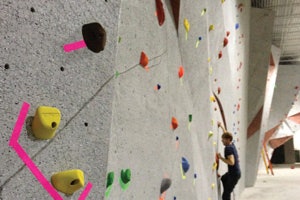 Click to enlarge
Click to enlarge
Nicros inc. Climbing Wall Systems
Opening this month in Chicagoland area, the new Nicros-built Vertical Endeavors-Glendale Heights boasts more than 44,000 square feet of climbing wall surface, making it the largest indoor climbing gym in the U.S. The facility's unique design, hand-sculpted cracks, arches and impressive overhangs all showcase the quality and versatility that Nicros Climbing Wall Systems can provide for any new gym project.
www.nicros.com
(800) 699-1975
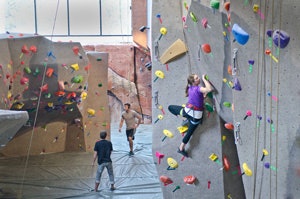 (Photo Courtesy of Eldorado wall) Click here to see more
(Photo Courtesy of Eldorado wall) Click here to see more
Eldorado Climbing Walls
The wall-mounted Gecko™ modular climbing wall is an affordable, space-sensitive, highly featured climbing structure. A realistic, natural look is visually stunning, and the rock-like features and texture offer a great climbing experience. The easy-to-assemble components can be configured to fit any space and expanded as demand for climbing grows. Complete equipment and flooring packages also are available.
www.eldowalls.com
(303) 447-0512
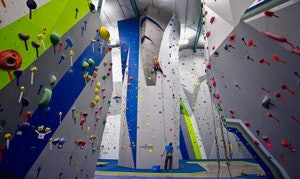 (Photo Courtesy of Entre-Prises climbing walls USA) Click here to see more
(Photo Courtesy of Entre-Prises climbing walls USA) Click here to see more
Entre-Prises Climbing Walls
Since 1985, Entre-Prises has realized the importance of continued development and renewing the climbing experience. To meet the evolving needs of gyms, the company has redesigned its MozaiK climbing wall technology with the modern demands for climbability and aesthetics in mind. Entre-Prises sales and design teams work closely with development teams, including architects, general contractors, business owners, climbers and route setters to provide the best solution for any facility, going beyond walls themselves to address the need for open spaces with natural light, clean lines, bright colors and comfortable areas for people to socialize and share experiences.
www.entre-prises.com
(800) 580-5463
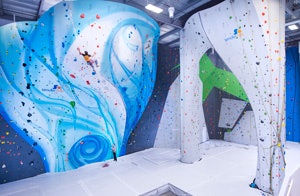 (Photo Courtesy of Walltopia) Click here to see more
(Photo Courtesy of Walltopia) Click here to see more
Walltopia
Founded in Bulgaria in 1996 as a manufacturer of climbing walls, Walltopia quickly expanded into developing highly specialized and unique products for indoor climbing. Today, Walltopia operates on four continents and distributes to 34 countries through its offices in the U.S., Canada, the U.K., Russia and Bulgaria. With more than 160,000 square meters of cutting-edge and innovative climbing, Walltopia is one of the world's largest climbing wall manufacturers.
www.walltopia.com
(412) 251-0532

A Map of climbing gyms that have opened or will be opening this year.
This article originally appeared in the August 2014 issue of Athletic Business titled, "Peaked Interests."





































